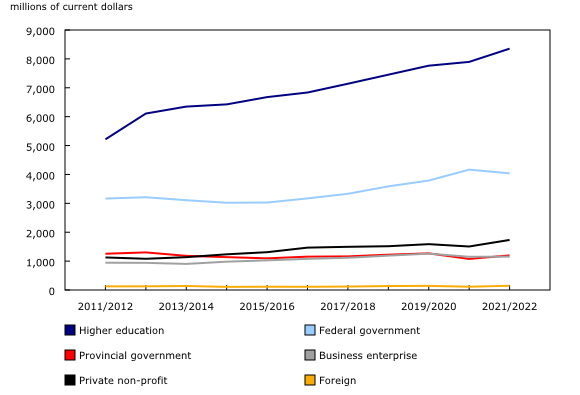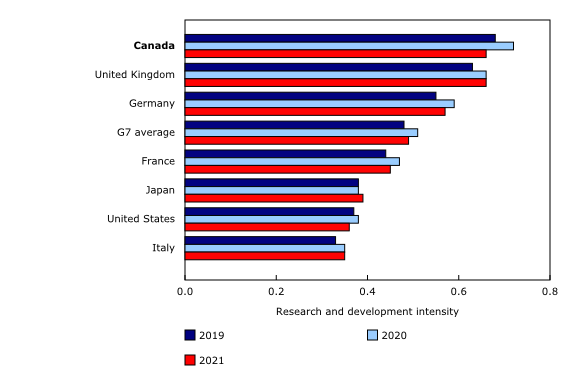Spending on research and development in the higher education sector, 2021/2022
Released: 2023-12-01
$16.6 billion
2021/2022
4.5% 
(annual change)
Higher education institutions play an integral role in performing research and development (R&D) in Canada. In fact, Canadian institutions have been responsible for major inventions related to telecommunications equipment and space technologies, as well as breakthroughs in the development of vaccines and medical instruments.
In 2021/2022, the higher education sector in Canada spent $16.6 billion on R&D, an increase of 4.5% from the previous year. This marked the 12th consecutive annual increase in R&D spending by the sector.
Research and development spending rises to record levels in both the natural and social sciences
In 2021/2022, both the natural sciences and engineering field of research and the social sciences, humanities and arts field reached their highest level of R&D spending. Spending in the natural sciences and engineering field rose 5.3% to $12.5 billion, while spending in the social sciences, humanities and arts field increased 2.1% to $4.1 billion.
Higher education R&D is funded through multiple channels, including institutional or internal resources, and external sources such as government grants, partnerships with businesses or foreign entities, and non-profit organizations.
In 2021/2022, the growth in R&D expenditures was driven mainly by funding from the higher education sector itself (+$459 million to $8.4 billion), followed by funding from the private non-profit sector (+$227 million to $1.7 billion). Offsetting this growth was a decrease in funding by the federal government, which declined $129 million (-3.1%) to $4.0 billion. This represents the first decrease in federal funding since 2014/2015.
Regional breakdown of research and development spending
The largest increases in R&D spending in 2021/2022 were observed in Quebec (+$354 million to $4.4 billion), followed by British Columbia (+$133 million to $1.9 billion) and Ontario (+$120 million to $6.6 billion).
Proportionally, Ontario (39.8%) and Quebec (26.7%) accounted for most of the R&D expenditures in 2021/2022.
Canada ranks among the G7 countries with the highest research and development intensity
Canada's higher education R&D intensity, measured as R&D expenditures by the higher education sector per nominal gross domestic product (GDP), decreased from 0.72 in 2020/2021 to 0.66 in 2021/2022. Despite this decline, Canada ranked alongside the United Kingdom as having the highest R&D intensity in the higher education sector among the Group of Seven (G7) countries.
The decrease in intensity was the result of the Canadian economy accelerating at a faster pace (+13.4% in nominal GDP) than R&D spending by the higher education sector (+4.5%) from 2020 to 2021. The 0.66 intensity rate is also more in line with intensity levels observed before the COVID-19 pandemic.
Did you know we have a mobile app?
Get timely access to data right at your fingertips by downloading the StatsCAN app, available for free on the App Store and on Google Play.
Note to readers
Concepts for expenditures on research and development in the higher education sector
The higher education sector is composed of all universities, colleges of technology and other institutions that provide formal tertiary education programs, as well as all research institutes and centres, experimental stations, and clinics that are affiliated with higher education institutions.
Higher Education Research and Development (HERD) estimates are a large component of Canada's overall gross expenditures on research and development (R&D). Science and technology (S&T) activities conducted by higher education institutions produce knowledge that leads to innovations in the other performing sectors of the economy. Moreover, HERD spending increases the capacity of S&T activities that researchers are able to perform in all sectors of the Canadian economy.
Total expenditures on R&D are classified into two fields of science: natural sciences and engineering and social sciences, humanities and the arts.
There are six funding sources for R&D expenditures in the higher education sector: business enterprises, private non-profit organizations, the federal government, provincial governments, the foreign sector and internal funding from the higher education sector.
The R&D intensity of a country is the ratio of R&D expenditures to gross domestic product (GDP). This can also be calculated for the sectors of a country's economy. This indicator facilitates comparisons both over time and between countries.
With the release of data for the reference period 2019/2020, previously released data from 2010/2011 to 2018/2019 have been revised.
For further information on concepts and definitions relating to R&D expenditures in the higher education sector, please see this release's "Related information" tab.
References
Organisation for Economic Co-operation and Development (OECD). (2015). Frascati Manual 2015: Guidelines for Collecting and Reporting Data on Research and Experimental Development, The Measurement of Scientific, Technological and Innovation Activities, OECD Publishing, Paris.
Main Science and Technology Indicators. (2023). On this page, select "HERD as a percentage of GDP" from the dropdown list.
Contact information
For more information, or to enquire about the concepts, methods or data quality of this release, contact us (toll-free 1-800-263-1136; 514-283-8300; infostats@statcan.gc.ca) or Media Relations (statcan.mediahotline-ligneinfomedias.statcan@statcan.gc.ca).
- Date modified:


